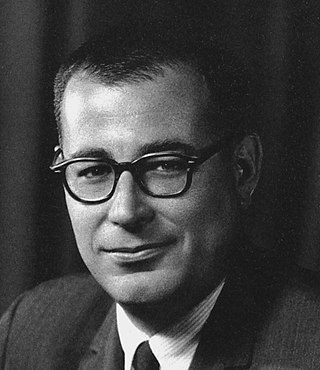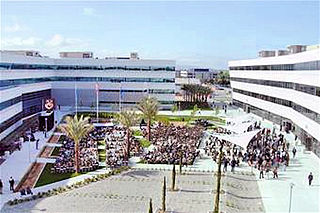Related Research Articles

World War III, World War 3, WWIII, WW3, or the Third World War are the names given to a hypothetical global conflict subsequent to World War I and World War II. The term has been in use since as early as 1941. Some apply it loosely to limited or more minor conflicts such as the Cold War or the war on terror. In contrast, others assume that such a conflict would surpass prior world wars in both scope and destructive impact.

The Defense Intelligence Agency (DIA) is an intelligence agency and combat support agency of the United States Department of Defense, specializing in defense and military intelligence.

Harold Brown was an American nuclear physicist who served as United States Secretary of Defense from 1977 to 1981, under President Jimmy Carter. Previously, in the John F. Kennedy and Lyndon B. Johnson administrations, he held the posts of Director of Defense Research and Engineering (1961–1965) and United States Secretary of the Air Force (1965–1969).
A revolution in military affairs (RMA) is a hypothesis in military theory about the future of warfare, often connected to technological and organizational recommendations for military reform.
The Farewell Dossier was the collection of documents that Colonel Vladimir Vetrov, a KGB defector "en place", gathered and gave to the Direction de la surveillance du territoire (DST) in 1981–82, during the Cold War.

The United States Strategic Command (USSTRATCOM) is one of the eleven unified combatant commands in the United States Department of Defense. Headquartered at Offutt Air Force Base, Nebraska, USSTRATCOM is responsible for strategic nuclear deterrence, global strike, and operating the Defense Department's Global Information Grid. It also provides a host of capabilities to support the other combatant commands, including integrated missile defense; and global command, control, communications, computers, intelligence, surveillance, and reconnaissance (C4ISR). This command exists to give "national leadership a unified resource for greater understanding of specific threats around the world and the means to respond to those threats rapidly".

Los Angeles Air Force Base (LAAFB) is a United States Space Force base located in El Segundo, California. Los Angeles Air Force Base houses and supports the headquarters of the Space Systems Command field command of the United States Space Force, which was established on August 13, 2021. The center manages research, development and acquisition of military space systems.
Able Archer 83 was a military exercise conducted by NATO that took place in November 1983. It simulated a period of heightened nuclear tensions between NATO and the Warsaw Pact, leading to concerns that it could have been mistaken for a real attack by the Soviet Union. The exercise is considered by some to be one of the closest moments the world came to nuclear war during the Cold War. It was the annual Able Archer exercise conducted in November 1983. The purpose of the exercise, like previous years, was to simulate a period of conflict escalation, culminating in the US military attaining a simulated DEFCON 1 coordinated nuclear attack. The five-day exercise, which involved NATO commands throughout Western Europe, was coordinated from the Supreme Headquarters Allied Powers Europe (SHAPE) headquarters in Casteau, Belgium.

The militarisation of space involves the placement and development of weaponry and military technology in outer space. The early exploration of space in the mid-20th century had, in part, a military motivation, as the United States and the Soviet Union used it as an opportunity to demonstrate ballistic-missile technology and other technologies having the potential for military application. Outer space has since been used as an operating location for military spacecraft such as imaging and communications satellites, and some ballistic missiles pass through outer space during their flight. As of 2018, known deployments of weapons stationed in space include only the Almaz space-station armament and pistols such as the TP-82 Cosmonaut survival pistol.

The Directorate of Operations (DO), less formally called the Clandestine Service, is a component of the US Central Intelligence Agency. It was known as the Directorate of Plans from 1951 to 1973; as the Directorate of Operations from 1973 to 2005; and as the National Clandestine Service (NCS) from 2005 to 2015.

The Central Intelligence Agency (CIA), known informally as the Agency and historically as the Company, is a civilian foreign intelligence service of the federal government of the United States tasked with gathering, processing, and analyzing national security information from around the world, primarily through the use of human intelligence (HUMINT) and conducting covert action through its Directorate of Operations. The agency is headquartered in the George Bush Center for Intelligence in Langley, Virginia.
Operation RYAN was a Cold War military intelligence program run by the Soviet Union during the early 1980s when they believed the United States was planning for an imminent first strike attack. The name is an acronym for Raketno-Yadernoe Napadenie. The purpose of the operation was to collect intelligence on potential contingency plans of the Reagan administration to launch a nuclear first strike against the Soviet Union. The program was initiated in May 1981 by Yuri Andropov, then chairman of the KGB.

Space Systems Command (SSC) is the United States Space Force's space development, acquisition, launch, and logistics field command. It is headquartered at Los Angeles Air Force Base, California, and manages the United States' space launch ranges.

The Under Secretary of Defense for Acquisition and Sustainment, or USD (A&S), is the Principal Staff Assistant (PSA) and advisor to the Secretary of Defense for all matters relating to acquisition and sustainment in the Department of Defense. This includes the DoD Acquisition System; system design and development; production; logistics and distribution; installation maintenance, management, and resilience; military construction; procurement of goods and services; material readiness; maintenance; environment and energy resilience ; utilities; business management modernization; International Armaments Cooperation, Cooperative Acquisition and International Agreements, Promoting exportability of military components to allies and partners; nuclear, chemical and biological defense programs; and nuclear command, control, and communications.
The military modernization program of the People's Liberation Army (PLA) which began in the late 1970s had three major focuses. First, under the political leadership of 3rd paramount leader Deng Xiaoping, the military became disengaged from civilian politics and, for the most part, resumed the political quiescence that characterized its pre-Cultural Revolution role. Deng reestablished civilian control over the military by appointing his supporters to key military leadership positions, by reducing the scope of the PLA's domestic non-military role, and by revitalizing the party political structure and ideological control system within the PLA.
This article deals with activities of the U.S. Central Intelligence Agency, specifically dealing with arms control, weapons of mass destruction (WMD) and weapons proliferation. It attempts to look at the process of tasking and analyzing, rather than the problem itself, other than whether the CIA's efforts match its legal mandate or assists in treaty compliance. In some cases, the details of a country's programs are introduced because they present a problem in analysis. For example, if Country X's policymakers truly believe in certain history that may not actually be factual, an analyst trying to understand Country X's policymakers needs to be able to understand their approach to an issue.
With Europe stabilizing along the Iron Curtain, the CIA attempted to limit the spread of Soviet influence elsewhere around the world. Much of the basic model came from George Kennan's "containment" strategy from 1947, a foundation of US policy for decades.
Technical Intelligence (TECHINT) is intelligence about weapons and equipment used by the armed forces of foreign nations. The related term, scientific and technical intelligence, addresses information collected or analyzed about the broad range of foreign science, technology, and weapon systems.

Anti-Access/Area Denial is a military strategy to control access to and within an operating environment. In an early definition, anti-access refers to those actions and capabilities, usually long-range, designed to prevent an opposing force from entering an operational area. Area denial refers to those actions and capabilities, usually of shorter range, designed to limit an opposing force's freedom of action within the operational area. In short, A2 affects movement to a theater, while AD affects movement within a theater. A2/AD typically refers to a strategy used by a weaker opponent to defend against an opponent of superior skill, although a stronger opponent can also use A2/AD.

Main Intelligence Directorate, abbreviated GRU, was the foreign military intelligence agency of the General Staff of the Soviet Armed Forces until 1991. For a few months it was also the foreign military intelligence agency of the newly established Russian Federation until 7 May 1992 when it was dissolved and the Russian GRU took over its activities.
References
- ↑ Weiss, Gus W (1996), "The Farewell Dossier: Duping the Soviets", Studies in Intelligence , Central Intelligence Agency, archived from the original on June 13, 2007
Line X
Context:
Line X was an operation by the Soviet Union that was established during the Cold War. The operation mainly sent spies from Russia to acquire technology from the West, primarily from the United States. The Soviet Union's intelligence agencies thoroughly targeted technological advancements and weapons created in Western countries to strengthen their own military and technological capabilities. [1]
Motives:
The reason behind the operation was the threats posed by the United States and some of its allies. The mission’s primary goal was to strengthen their defense systems by utilizing radars and warning them about incoming missile attacks, allowing the Soviet Union to prepare for and defend against the attacks swiftly. They also needed superior weaponry to match or overpower the quality of their enemies, forcing them to seek out high-end Western technology. Line X operated through encrypted channels using advanced technology to ensure their messages were safely transmitted without interception by their adversaries. [1]
Methods:
There were many effective methods through which the Soviet Union acquired technology. They recruited agents from governments and the military primarily in the United States, although some agents operated overseas. They also arranged illegal trade through third countries to elude the United States’ export control and made good use of intercepting messages from the United States and other Western countries to obtain important information. Some other methods included exploiting technological transmissions and collecting information that was available in Western countries. The Soviet Union's espionage network was sophisticated, allowing them to effectively gather and utilize Western technological advancements. [1]
History: Over time, the Soviet Union made acquiring United States technology an important aspect of their military strategy. They became more selective about the weapons and components they collected, focusing on the most advanced and strategically important technologies. Recently, they have increased the quality and expanded the set of requirements needed to join the European Intelligence Services. Since Line X was created, the Soviet Union has made acquiring technology a priority, whether it was obtained legally or illegally. The main objective was to support Warsaw Pact military programs. This helped them develop better weapons, improve existing ones, decrease costs, and increase efficiency in the Soviet Union’s defenses. The acquisition of technology began in the 1930s, and due to the high level of effort, the USSR and Warsaw Pact increased their military capabilities significantly. This intense focus on technological acquisition forced the United States to consume more materials and resources to strengthen its defense efforts in response. The Soviet Union's efforts extended to nuclear weapons developed in the United States, which were also copied. Many nuclear warheads, advanced explosives, and missiles benefited the Soviet Union’s defense and military systems. Some weapons were even replicated entirely, such as the US Sidewinder missile and the US Redeye missile. The impact of these acquisitions was enormous, as they allowed the Soviet Union to strengthen its defense capabilities, maintain a technological advantage, and ensure its military remained powerful and modern during the Cold War. The strategic importance of these technological acquisitions played a significant role in the balance of power during this period and showed how the Soviet Union was able to take advantage of its adversaries. [1]
[1] "Soviet Acquisition of Militarily Significant Western Technology: An Update." Central Intelligence Agency, https://www.cia.gov/readingroom/docs/DOC_0000261337.pdf. Accessed 23 May 2024.